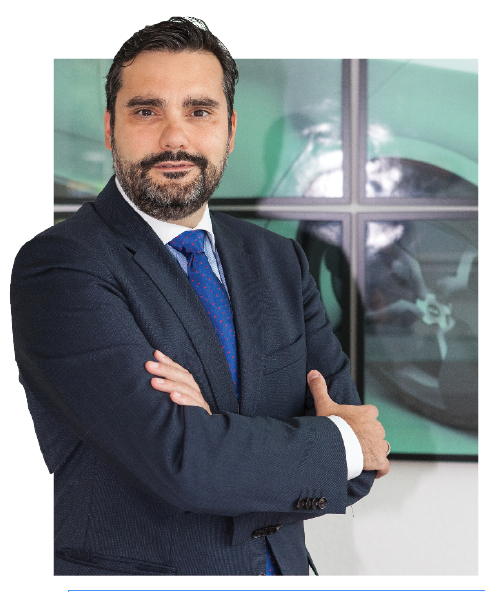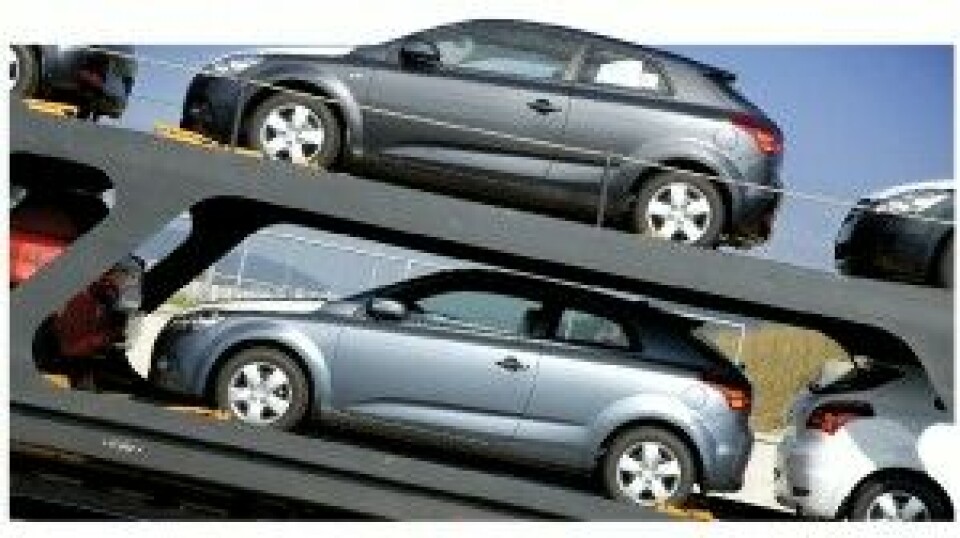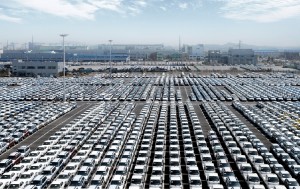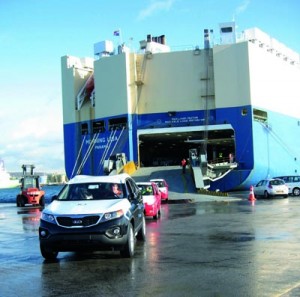Delivering a new world of order

Carlos Lahoz (left) reveals how Kia is honing its forecasting and supply chain process across Europe, including improving vehicle allocation and material forecasting. Glovis Europe also discusses its ambitions for Hyundai-Kia’s logistics and beyond
A company selling more cars than it has capacity to build can be a ‘good problem’ to have, certainly compared to the opposite, but for a supply chain manager it means there is little room for error in planning production, moving inventory and delivering vehicles. Any delayed product, whether because of a logistics bottleneck, damage or a poor forecast, often has a final customer waiting for the keys who is ready to take his money elsewhere if promises on delivery are not met.
That is the situation today for Kia Motors Europe (KME), which is responsible for sales and distribution across some 30 countries from the UK to Romania. In a region that saw sales decline nearly 20% between 2008 and 2013, the Korean brand rose almost 70%. Sales are up another 5% in the first seven months of 2014, on the way to nearly 400,000 units.
In this story...
- Improving delivery
- Implementing strategy
- Looking local for bottlenecks
- Innovating OTD
- Future supply chain
Second part of feature:
The carmaker’s factory in Zilina, Slovakia, which builds the Sportage, cee’d and Venga models, along with petrol and diesel engines, is at full capacity, as are the factories serving Europe in South Korea. Thus, one of Kia’s top priorities this year has been to improve visibility in its order and delivery processes, including more accurate estimated times of arrival (ETAs) to customers, says Carlos Lahoz, director of sales business planning and supply chain management.
“For KME, due to our current sales momentum, vehicle logistics is a key element in the maximisation of sales in Europe,” he says. “A wrong allocation process or any misalignment between market demand and factories will imply a production delay and a consequent loss of sales.
“For Kia, an efficient vehicle logistics structure is a clear competitive advantage in the automotive industry,” he adds.
Lahoz, who is on the board of directors at KME, says top management takes great interest in vehicle logistics performance, including measuring stock turns, inventory and delivery accuracy. Together with the Hyundai Group’s in-house logistics provider, Glovis Europe, Lahoz and his team are constantly monitoring logistics KPIs and efficiency, from delivery lead times to damage-related delays.
There are a number of projects that Kia is currently working on to improve delivery. These include re-engineering complex planning processes and systems that relate to allocating volumes to each market, such as refining in-depth material forecasts and prioritising production and delivery for sold customers. While Glovis has principle responsibility for logistics purchasing (which it combines with Hyundai) and in some cases operations, Kia is also looking at how it can improve logistics flows. For example, Lahoz is interested in introducing more centralised stock management for some markets, with vehicle distribution centres serving multiple markets rather than the decentralised, country compounds that Kia uses for most countries.
These supply chain planning projects and logistics concepts are part of an ‘OTD (order-to-delivery) innovation strategy’ that Kia plans to launch this year, which will aim to improve visibility of orders, reduce lead time and improve the predicted accuracy of delivery times.
Where strategy meets implementation
Kia’s top management sees logistics and ETA improvements as important to achieving a medium-term target of profitably selling 500,000 vehicles in Europe, as well as a long-term strategy that Lahoz and his team are currently crafting. While much of the company’s sales and local distribution operations are in the hands of national sales companies, Lahoz leads a team that combines strategy and supply chain planning, folding together branding ambitions, demand and order planning, production control, volume allocation and order-to-delivery processes. At the same time, the group also leads efficiency projects across KME’s markets in areas as diverse as finance, marketing, aftersales and logistics. Lahoz reports directly to chief operating officer Michael Cole. “We wanted to have all of the co-ordination of strategy together with a very operational area,” says Lahoz. “It is a way to keep our feet on the ground and to say that, yes, having a strategy is fantastic, but implementation is even more important.”
Like the diversity of his current role, Carlos Lahoz’s background runs across brand strategy, supply chain and sales operations. He started his career 15 years ago with General Motors Europe, working across a variety of sales, marketing and planning positions, before running fleet and used car sales for Fiat in Spain.

He joined Kia in 2010, initially as a senior manager for sales and logistics at its Iberian subsidiary. He led a major project to improve stock management there that included consolidating the company’s vehicle stock in one compound. The results were outstanding: after the change, more than 50% of cars were delivered in fewer than four days after the transport order, while stocks were reduced by 65%.
Lahoz started at Kia’s European headquarters in Frankfurt three years ago, tasked with implementing the company’s strategy and improving supply chain management. His team has since expanded from just three staff members to around 15, which he believes indicates how important business planning and SCM has become for KME’s top management.
Allocating all the details
Getting the ETA right for customers and dealers is a complex tool in which the logistics of final delivery are just the sharp end. It starts with market forecasts, combining end customer orders and dealer stock, areas in which Lahoz and his team have made improvements over the past three years. He and Giuseppe Galluzzo, European manager of supply chain management, say that Kia’s switch from built-to-stock production to built-to-order production has improved the availability of hot-selling models. KME also improved the accuracy of its production by doing allocation at ‘full specification derivatives’; this means that vehicles are not just allocated to plants by model and engine type, but with all option details.
“That way, at KME HQ we are able to give a very detailed material forecast to our factories,” Galluzzo says.
Each European market makes a five-month plan at this detail, with updates every month. Meanwhile, the markets must place their production orders based on the sales order portfolio and stock requirements. KME collects the orders and distributes volume by market before finalising the allocation with top management and sending the figure to manufacturing plants in Europe and Korea.
The process, says Lahoz, involves constant negotiations – if not occasional conflict – with national sales companies over allocated volume. “We fix volumes every year according to every kind of variable, but each month it is a negotiation,” he says. “Once the figures are set, we revise them every quarter and month. If one country is overselling their plans, then we need to reallocate their stock.”
This year, for example, Kia has seen higher than expected growth in the UK (its largest European market), Italy and Spain. “These are markets in which we are trying to allocate more volume than originally planned,” Lahoz says.
For production scheduling, exceptional changes can be made up to three weeks before the build date for the Korean plants, and two weeks beforehand for Zilina. This leeway gives KME the opportunity to prioritise production based on customer orders, says Galluzzo. Typically, a fleet order with a contracted delivery time gets first priority, followed by final customer orders and lastly dealer stock orders. Getting this priority right is important, because if a dealer identifies a vehicle as sold, but it is then rejected by the customer, it could stay in a compound for several months even as other customers wait on back orders.

Focusing production on actual orders first helps improve operations across the supply chain. In a time of low vehicle inventory and tight production capacity, Lahoz notes that dealers can sometimes over-order their stocks – requesting 15 vehicles in the hope that they get ten, for example – but such an approach leads to more back orders and more inaccurate material forecasts should those orders turn from stock to sold, and specify a different set of options. Such changes put pressure on the plant, on suppliers and on logistics.
“If you make a material forecast based on such an order forecast, you could make a mistake and end up using your capacity for the wrong mix of vehicles,” says Lahoz.
Every lead time is local
Factoring in logistics lead times and constraints is among the final pieces of production planning and defining a vehicle’s ETA. Kia must consider local conditions carefully: the lead time from Slovakia to Tarragona, Spain is two or three days by truck, for example, while going to Sweden or the UK can take three times longer due to waiting times for rail and ships. A high percentage of vehicles bound for Italy, meanwhile, have post-production transformations that can add 15 days.
One point worth noting is that Kia’s supply chain and allocation processes are not in any way shared or combined with those of Hyundai. While the two brands share development costs, platforms and logistics via Glovis, Giuseppe Galluzzo states that the brands are like “any other competitor” on the market and thus the allocation process is separate. Combining volume for logistics, however, makes sense and it is something that Lahoz would be happy to see, even with other brands. “If I could do it with Toyota or Ford, I would,” says Lahoz. “I have no problem to share certain flows with other manufacturers if it would improve Kia’s KPIs.”
 "For KME, due to our current sales momentum, vehicle logistics is a key element in the maximisation of sales in Europe. A wrong allocation process or any misalignment between market demand and factories will imply a production delay and a consequent loss of sales."
"For KME, due to our current sales momentum, vehicle logistics is a key element in the maximisation of sales in Europe. A wrong allocation process or any misalignment between market demand and factories will imply a production delay and a consequent loss of sales."
- Carlos Lahoz, Kia Motors Europe
That is a sentiment very much shared by managers at Glovis Europe. Frank Schnelle, general manager, would like to share more information with other OEMs that would allow it to fill empty miles. In some examples, there may be benefits in co-ordinating tenders and unifying some aspects of contracts to allow providers to capture backhauls. “Having a similar timing for tenders would support competition on certain routes and could minimise empty miles,” Schnelle says.
Looking for OTD innovations
Despite progress in order management and logistics analysis, Lahoz admits that the company is continuously looking for improvements in its ETA and allocation accuracy. The complexities of serving the European market are a factor, as options and post-production modifications vary by market, whether it is climate control systems in Sweden or converting engines to use liquid petroleum gas in Italy. These variations mean that once a vehicle is delivered and localised, it is more complex to move it between countries as a stock transfer. “We normally look at doing such transfers between countries when we have ageing stock, but we don’t have any ageing stock right now,” says Lahoz.
Refining the material forecast further will be an important part of the OTD innovation project. “The accuracy of our material forecast and demand is an obsession for KME,” notes Lahoz. “If Europe makes the wrong forecast and material plan, and the [Korean] factories cannot cope with it, they will switch to production for other regions. And every car that we don’t produce for Europe, or which is produced inefficiently, is a lost sale.”

Another part of the OTD strategy will be to improve Kia’s prioritisation process so that the right vehicles get built and shipped first. That will require more accurate information and data exchange between dealers, national sales companies and KME. When asked if upgraded IT systems with more automated processes would be part of the fix, Lahoz says Kia’s ordering systems already have some levels of automation. However, he believes much still needs to be based on manual analysis and business intelligence. The tendency for dealers to over-order stocks for vehicles that are in limited supply, for example, means that automated changes to production and material planning would be based on inaccurate forecasts.
“When we have a constrained production, such IT systems do not fully work. Rather, we still require a lot of manual adjustments and refining of the forecasts based on deliveries from real customers,” he says.
The value of logistics performance
Lahoz and his team look at logistics KPIs to determine where efficiency projects might be implemented. One example has been checking for logistics bottlenecks, particularly in markets that lost service capacity during the recession. Lahoz admits that poor performance by providers can put sales at risk. “We do not negotiate directly [with providers], but we have KPIs to see the number of days from call-offs and on lead times,” he says. “We address our concerns to the market and set up an action plan together with Glovis and the national sales company, and give our recommendations.”
Lahoz and his team are exploring ways to reduce lead times further, including multi-country distribution centres. Lahoz was already responsible for a similar project on a smaller scale at Kia Iberia that centralised stocks at one compound for Spain and Portugal. Once Lahoz and his team have negotiated with local markets on how to share stock and allocate volume, Glovis will contract and implement the hubs.
Lahoz is also interested in more direct dealer delivery services of customer-allocated vehicles from Zilina and ports, including its main entry point at Koper, Slovenia. “These are options we are considering for the near future,” he says.
He also sees more scope for multimodal transport. Currently, rail mainly covers peaks in the network. About 15% of Kia’s production out of Slovakia moves by rail, including exports, as Glovis directs a block train between Zilina and the Hyundai factory in Nosovice, in the east of the Czech Republic. Use of the mode is on the rise, says Lahoz. In the first quarter of this year, there were an average of five trains per week from Slovakia, which increased to six trains in the second quarter. Combined with Hyundai, Glovis is moving 17 trains per week with about 22% of all production out of the two factories.
Glovis uses short-sea shipping more for Kia’s European production more than it does rail, with about 23% of production touching the water, moving mainly to the UK and Turkey. Combined with Hyundai, short-sea shipping is a lower proportion at around 19% of European production.

Lahoz is interested in increasing multimodal transport by water as well, but notes that local conditions and service vary greatly. “We have options between overland and short-sea to Turkey, for example, but rail transport to Turkey is much too expensive and has a higher risk of damage and vandalism,” he says. “On the other hand, we can move to Spain by sea via Koper or Livorno, but our current scheme is to use a combination of road and rail.”
Frank Schnelle also says that Glovis Europe is actively looking to increase rail use for both Hyundai and Kia as part of an expanded network of providers and services in Europe. “We are aiming to increase rail operations as well as to extend and develop the number of logistics suppliers and logistics providers that we work with,” he says.
Sometimes, Lahoz’s team even gets involved directly in logistics at the plant. Following a series of scratches to vehicle roofs, for example, they found that the glue used to fix the plastic protection onto the car was insufficient, which led to air getting into the coverings and subsequently to small scratches. The plant switched glue suppliers and the problem was solved. In another case, the supply chain group discovered that consistent damage close to the door handles for cee’d models was the result of protection that was being wrongly set by about 10 centimetres.
A strategy for the future supply chain
At the time of writing, Lahoz is finalising new three-year and five-year strategies that establish volume targets and look to address wider changes in the sector. Lahoz points to shifting customer perceptions and behaviours in Europe that inform the new strategies, including increasing digitisation and a rise in usage-based mobility models (like car sharing) rather than ownership. Lahoz cannot give more details until Kia Motors Corporation in Korea approves the plans, but he does say that they include revisions to more than 70 company-wide KPIs.
Such plans require Lahoz to step back and evaluate Kia’s branding and values, but it helps too that he is leading projects to improve operations in areas like vehicle protection or stock management. This illustrates how the supply chain group is the company’s “implementation centre”, so that those setting lofty targets for the company are also living the reality on the ground. Too often, says Lahoz, there is a disconnect at large companies between a strategy and its implementation.
Logistics is not the only part of Kia’s strategic plans, but Lahoz suggests that its top management understands how important these processes are to volume, finances and customer satisfaction. To this end, an overarching strategy that encompasses logistics can really make a difference. If Kia’s executives want it to stay as competitive as it is today over the next decade, they need a supply chain that does more than just keep up with European demand; it needs to be working ahead of it, and that is what Lahoz has set out to do.





